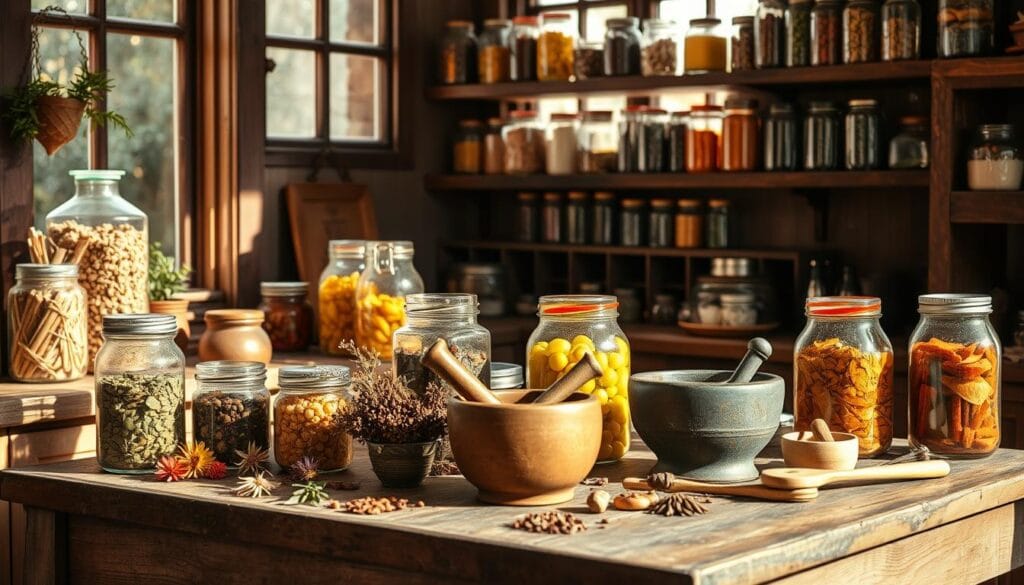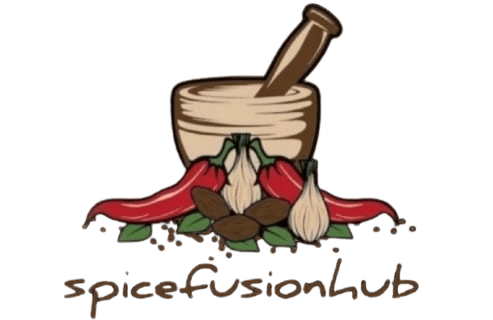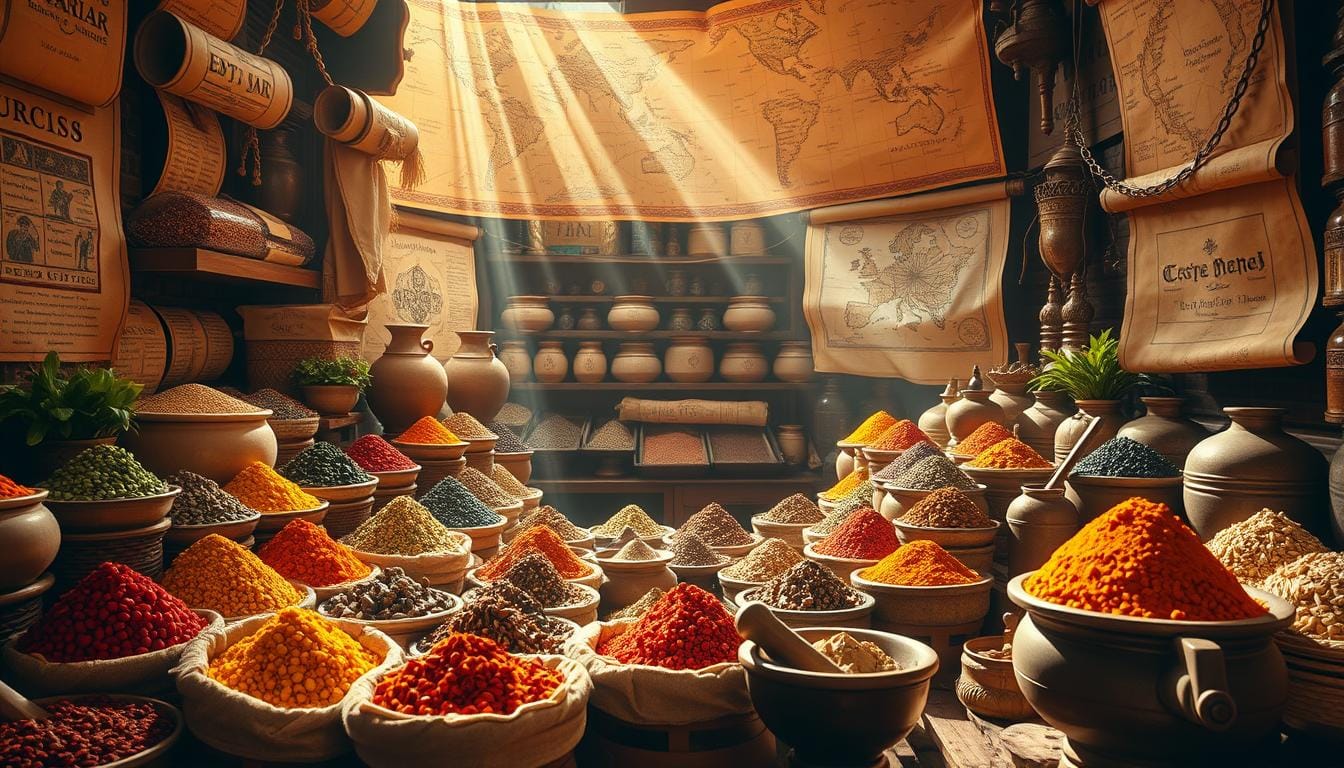Explore the Rich History of Spices in Cooking
Ever wondered how a simple spice can make a dish amazing? Let’s take a flavorful journey into the history of spices in cooking. We’ll see how they’ve changed the culinary world.
Spices have added flavor and smell to our food for centuries. They’ve also shaped global cuisine and cultural exchanges. The story of spices shows their big impact on food and society.
Let’s dive into the origins of spices in ancient times. We’ll see their role in Rome and Greece’s food and economy. We’ll also explore their journey through the Middle Ages, Renaissance, and beyond. Plus, we’ll look at their health benefits and role in preserving food today.
Key Takeaways
- Discover the ancient origins of spices and their integration into early civilizations.
- Learn how spices influenced global trade routes and economic developments.
- Understand the cultural significance and social impact of spices throughout history.
- Explore the transformative role of spices in the evolution of culinary arts.
- Gain insights into the health benefits and preservation techniques involving spices.
- Recognize the ongoing significance of spices in modern global cuisine.
Origins of Spices in Ancient Civilizations
Spices have a long history, starting in ancient civilizations. They were key in Mesopotamia, Egypt, and India. These places were fertile and lush, perfect for growing spices.
Spices in Mesopotamia and Egypt
Mesopotamia, between the Tigris and Euphrates rivers, was the first civilization. Archaeologists found evidence of spices like cumin and coriander. These were used for food, medicine, and rituals.
In Egypt, spices were a big part of life. They used garlic, mustard, and cinnamon. Egyptians also used spices to preserve bodies, showing their importance in trade.
The Role of Spices in Ancient India
India was a major spice center from the start. The Vedas talk about spices like turmeric, black pepper, and cardamom. These were grown in big gardens and used in cooking, medicine, and rituals.
India’s spice knowledge was passed down for generations. It shaped their culture and influenced the world through trade.
Trade Routes and Spice Exchange
Spices were among the first things traded across borders. The Incense Route and the Silk Road helped. These routes connected Mesopotamia, Egypt, and India.
These trade routes were key for spice exchange and sharing knowledge and culture. Spices were symbols of wealth and power, affecting empires.
Spices in Ancient Rome and Greece
The ancient civilizations of Rome and Greece loved spices. They used them to make their food taste amazing. This love for spices helped shape the Mediterranean cuisine we know today.
Commonly Used Spices in Roman Cuisine
In Ancient Rome, spices were a big deal. They were used by the rich to make their food taste special. The book De Re Coquinaria by Apicius lists many spices used by the Romans:
- Pepper
- Cumin
- Coriander
- Saffron
- Mustard
These spices made meats, fish, and wines taste better. They were a sign of wealth and status.
Greek Influences on Mediterranean Cooking
In Ancient Greece, spices were also very important. Greek food was flavored with herbs and spices from their trade. Oregano, thyme, and mint were common, adding unique tastes to their dishes.
The Greeks valued spices not just for taste but also for health. This mix of taste and health benefits was key to Greek cooking.
Spice Trade and Its Economic Impact
The spice trade was crucial for Rome and Greece’s economies. Spices like black pepper, cinnamon, and cloves were highly valued. They helped create trade routes from the East to the Mediterranean.
| Spice | Origin | Economic Impact |
|---|---|---|
| Pepper | India | High demand spurred sea and land trade routes |
| Cinnamon | Sri Lanka | Valuable commodity, often exchanged for gold |
| Cloves | Indonesia | Founded new markets and created wealth |
The desire for spices helped these ancient societies grow economically. It improved their food and helped them connect with other cultures.
The Age of Exploration: Spices and Conquests
The Age of Exploration was a key time in history, driven by the search for spices. Explorers went on dangerous journeys for these valuable goods. This search led to the discovery and colonization of many places around the world.
Key Explorers and Their Spice Journeys
Christopher Columbus and Vasco da Gama were among the famous explorers. Columbus looked for a new route to Asia but found the Americas. Vasco da Gama found a sea route to India, opening up spice markets.
Their stories are well-documented in explorer logs and maritime histories. These tales show the risks and rewards of their quests.
The Spice Trade’s Influence on Colonization
The spice trade changed the world in big ways. The need for spices and the profits they brought led to European colonization. This marked the start of a new era of colonization, aimed at controlling spice resources.
This period shaped the modern world’s politics and geography. The quest for spices was a major driver of these changes.
Cultural Exchange Through Spices
Spices moved across continents, leading to early globalization. They brought cultural exchange that changed local foods, languages, and customs. This exchange enriched societies and showed the value of diverse traditions.
Spices played a big role in shaping global history. For more on the history of spices, check out this resource.
Spices in the Middle Ages
During the Middle Ages, spices became key in European cooking. This change came from better trade routes and a love for new tastes. Recipes in “Le Viandier” show how spices were vital in medieval meals.
The Role of Spices in European Cuisine
Spices were used in many dishes in the Middle Ages. Favorites like black pepper, cinnamon, cloves, and nutmeg were common. They made food taste better and helped keep it fresh.
Meats, sauces, and sweets were often spiced. This made them taste richer and more complex.
Spices as Indicators of Wealth and Status
Having spices showed you were wealthy in medieval times. They were used as money and status symbols. The rich showed off with fancy, spiced feasts.
Spices were rare and expensive. Only the wealthy could afford them. Using spices in cooking showed you were fancy and refined.
The Rise of Spice Markets
Spice markets grew as people wanted more spices. Merchants, apothecaries, and traders were key in these markets. Venice was a major center for spice trade, connecting East and West.
The spice markets were crucial for medieval trade. They helped move goods and shaped the economy.

| Spice | Main Origin | Common Usage |
|---|---|---|
| Black Pepper | India | Meats, sauces |
| Cinnamon | Sri Lanka | Pastries, stews |
| Cloves | Indonesia | Meats, desserts |
| Nutmeg | Banda Islands | Sauces, beverages |
The Culinary Revolution of the Renaissance
The Renaissance brought a big change to how people ate in Europe. It introduced new ways of cooking and using spices. Spices became more than just food; they became symbols of culture and creativity.
Innovations in Cooking and Spice Use
Chefs in the Renaissance started to mix flavors in new ways. They used spices more carefully, moving away from the old heavy-handed approach. Recipes from then show a growing love for natural tastes, with spices adding depth without taking over.
The Significance of Spice in Art and Literature
The love for spices didn’t just stay in the kitchen. It also influenced art and writing. Paints, manuscripts, and poems often showed spices as symbols of wealth and culture. Famous artists like Leonardo da Vinci and writers like William Shakespeare used these elements in their work, showing the world’s interest in new tastes.
How Spices Shaped European Palates
The Renaissance changed how Europeans tasted food. It brought a focus on complex flavors and new spices. This led to the creation of new dishes and cooking styles, laying the groundwork for today’s diverse food scene.
The Role of Spices in Global Cuisine
Spices take us on a thrilling trip around the world. Each place has its own special flavors that make its dishes unique. From China’s Sichuan peppercorns to India’s cardamom, spices weave a rich tapestry of taste.
Regional Spices and Their Unique Flavors
Different climates and soils create a wide range of spices. For example, Middle Eastern sumac adds a zesty lemon flavor to many dishes. Meanwhile, Mexico’s chipotle peppers and Japan’s wasabi show how spices can make global cuisine so varied.
Fusion of Spices in Modern Dishes
Today’s chefs love to mix spices in new ways. This not only honors traditional flavors but also brings diners exciting new tastes. For example, combining Indian turmeric with Moroccan saffron in a paella is a great example of this.
Contemporary Spice Trends
Spice trends are always changing, focusing on health and sustainability. Chefs are adding spices like sumac and za’atar to dishes, highlighting their health benefits. Also, spice blends that make cooking easier and taste better are becoming more popular.
| Spice | Region | Notable Use |
|---|---|---|
| Sichuan Peppercorn | China | Sichuan Hot Pot |
| Cardamom | India | Garam Masala |
| Sumac | Middle East | Fattoush Salad |
| Chipotle | Mexico | Tacos |
| Wasabi | Japan | Sushi |
Health Benefits of Spices Throughout History
Spices were valued not just for their taste but also for their healing powers. They played a big role in the health of people in different cultures. Learning about the health benefits of spices shows how these special ingredients helped people stay well for centuries.
Medicinal Uses of Spices in Ancient Cultures
In old times, medicinal uses of spices were a big part of life. Ancient India used turmeric and ginger for their healing powers. These spices helped with inflammation and digestion. In Egypt, garlic was used to treat breathing problems.
How Spices Enhanced Nutrition
Spices did more than just add flavor; they also improved nutrition. In the Middle Ages, people used black pepper and cinnamon. These spices helped make food taste better and added important nutrients, especially in cold winters.
Modern Discoveries Regarding Spice Benefits
Today, we’re finding out more about the modern spice discoveries. Science has shown that spices like cinnamon help control blood sugar. Cumin is good for fighting off harmful free radicals. Studies now confirm that spices are a big help in keeping us healthy.
Preservation and Spices
Food preservation has always been key to keeping food safe and fresh. Spices have been vital in these efforts. They help extend shelf life and add flavor and nutrition.
Historical Methods of Preserving Food with Spices
Long ago, people found that spices could keep food from spoiling. In Mesopotamia and Egypt, they used garlic, cinnamon, and clove to preserve meat and fish. In India, turmeric and mustard seeds helped keep veggies fresh.

Spices in Fermentation and Pickling
Fermentation and pickling are old ways to keep food good. Spices like dill in pickles or chili in kimchi add flavor and nutrients. The lactic acid from fermentation acts as a natural preservative.
The Impact of Preservation on Culinary Traditions
Spices in preservation have shaped many cuisines. They’ve led to foods like sauerkraut in Germany and achaar in India. These traditions show how preservation techniques influence local diets. They also help in sharing and creating new dishes.
| Region | Preservation Technique | Dominant Spices | Common Foods |
|---|---|---|---|
| Mesopotamia | Drying and Salting | Garlic, Cinnamon | Meat, Fish |
| India | Pickling | Turmeric, Mustard Seeds | Vegetables |
| Germany | Fermentation | Dill, Caraway | Sauerkraut |
The Spice Industry Today
The spice industry is booming today, thanks to worldwide demand and new farming methods. It’s interesting to see who’s leading the way and how they’re doing it sustainably. This shows us where the industry is now and where it might go.
Major Spice-Producing Countries
India, Indonesia, China, and Vietnam are at the top of spice production. India leads, especially with black pepper, turmeric, and cumin. Indonesia and Vietnam are big too, with lots of nutmeg, cloves, and pepper. China is known for its ginger and garlic, thanks to its wide range of crops.
The Economic Significance of Spice Trade
Spices are very important for the economy. In places like India and Indonesia, they help a lot with GDP and jobs. The global spice market is huge, worth billions, and is growing fast.
Spice exports help countries grow and invest in farming. This boosts their economies and helps people in the industry.
Sustainable Practices in Spice Farming
It’s crucial to farm spices in a way that’s good for the planet. Using methods like crop rotation and organic farming helps the soil and cuts down on harm to the environment. Fair trade also helps farmers get better pay and work conditions.
Agro-ecology is another key part of sustainable spice farming. It focuses on keeping the ecosystem balanced and diverse. This way, spice farming can meet the demand for products that are both tasty and good for the planet.
Spices and Cultural Identity
Spices are more than just flavor enhancers; they are deeply rooted in the cultural identity and traditions of various communities. The unique blends and traditional recipes featuring spices tell stories of heritage and history. They preserve a culture’s culinary diversity for generations to come.
How Spices Define Culinary Heritage
The intricate use of spices is a defining element of culinary heritage. From the vibrant saffron in Spanish paella to the aromatic blend of garam masala in Indian cuisine, these spices are key. They are essential to maintaining the authenticity of traditional recipes.
They are an essential part of rituals, festivals, and everyday meals. This makes them indispensable to cultural festivities and daily life.
Recipes That Showcase Cultural Spice Traditions
Iconic recipes around the world highlight how spices are integral to cultural identity. For instance:
- Vietnamese Pho: A rich broth infused with star anise, cinnamon, and cloves.
- Mexican Mole: A complex sauce combining chocolate with a variety of spices like cumin, chili, and cinnamon.
- Moroccan Tagine: A flavorful stew made with cumin, ginger, and turmeric.
These dishes illustrate the diversity and richness of culinary heritage through their unique spice profiles. Each tells a story of the land they come from.
Celebrating Diversity Through Spice
In today’s globalized world, the exchange of spice-driven flavors promotes cultural diversity and understanding. As people explore different cuisines, they appreciate the traditions and histories tied to these spices. This celebration of culinary diversity enriches our global palette and fosters a sense of unity through shared gastronomic experiences.
The Future of Spices in Cooking
Spices are key in the future of cooking, adding depth and excitement. We’ll look at new spice trends, their role in plant-based foods, and innovative pairings. These are changing how we enjoy food today.
Emerging Spice Trends to Watch
New spice trends are exciting for cooking. We’re seeing artisanal blends and ancient spices like grains of paradise. These trends are changing our kitchens.
Food lovers are also excited about spice influences from different cultures. These influences are shaping modern dishes, showing how cooking traditions evolve.
Spices in Plant-Based and Health Foods
Spices are vital in plant-based foods, making them tasty and healthy. Turmeric, smoked paprika, and nutritional yeast are key in vegan and vegetarian dishes. They add depth and joy to plant-based meals.
Innovations in Flavor Pairing
Innovative flavor pairings are changing cooking. They mix unexpected spices and ingredients for new tastes. Think cardamom with coffee or chilies with chocolate.
These bold pairings come from culinary science and creativity. They open up new possibilities in cooking, pushing the limits of flavor.
| Spice | Traditional Use | Innovative Pairing |
|---|---|---|
| Cardamom | Tea and Sweet Dishes | Coffee and Citrus Fruits |
| Turmeric | Curry and Soups | Smoothies and Desserts |
| Smoked Paprika | Meats and Stews | Plant-Based Burgers and Pasta |
| Chilies | Sauces and Marinades | Chocolate and Cocktails |
Conclusion: The Lasting Legacy of Spices
Spices have shaped human history and culture deeply. They have traveled from ancient trade routes to today’s kitchens. This journey shows a rich mix of tradition, innovation, and global connections.
Reflections on the Journey of Spices
Spices have changed a lot over time. They went from being rare and valuable to common in our homes. Their story spans ancient civilizations and the Age of Exploration, showing their big impact on trade and culture.
Spices as Connective Threads in Global Cuisine
Spices link different cultures together, adding unique flavors to food worldwide. They mix the tastes of Indian curries with Mexican dishes. Today, fusion cuisine shows how spices from all over blend together, connecting us through food.
Preserving Spice Traditions in Modern Cooking
Keeping spice traditions alive is key in today’s cooking world. Passing down the knowledge and flavors of these ingredients shows respect for our culinary past. Teaching new cooks about spice history helps keep these traditions alive, enriching our kitchens and inspiring new flavors.







